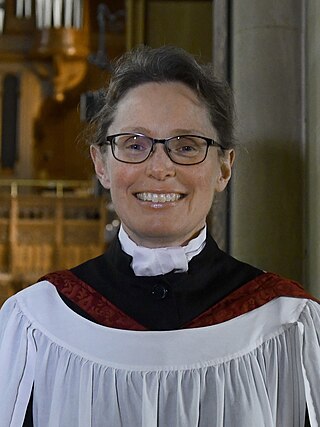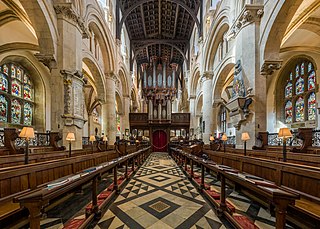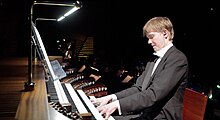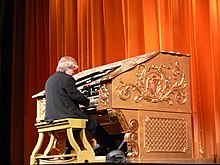
The Cathedral Church of St Peter and St Wilfrid, commonly known as Ripon Cathedral, and until 1836 known as Ripon Minster, is a cathedral in Ripon, North Yorkshire, England. Founded as a monastery by monks of the Irish tradition in the 660s, it was refounded as a Benedictine monastery by St Wilfrid in 672. The church became collegiate in the tenth century, and acted as a mother church within the large Diocese of York for the remainder of the Middle Ages. The present church is the fourth, and was built between the 13th and 16th centuries. In 1836 the church became the cathedral for the Diocese of Ripon. In 2014 the Diocese was incorporated into the new Diocese of Leeds, and the church became one of three co-equal cathedrals of the Bishop of Leeds.
Sir Edward Cuthbert Bairstow was an English organist and composer in the Anglican church music tradition.

John Scott Whiteley is an English organist and composer. He has performed extensively around the world and since 1985 has undertaken an annual tour of the US. He has performed in most major UK cathedrals and concert halls, and was Assistant Organist and later Organist and Director of the Girls' Choir at York Minster between 1976 and 2010. He is currently Organist Emeritus of York Minster.

Chelmsford Cathedral in the city of Chelmsford, Essex, England, is dedicated to St Mary the Virgin, St Peter and St Cedd. It became a cathedral when the Anglican Diocese of Chelmsford was created in 1914 and is the seat of the Bishop of Chelmsford.

Francis Alan Jackson was a British organist and composer who served as Director of Music at York Minster for 36 years, from 1946 to 1982.
Ian Graham Tracey DL is an English organist and choirmaster who has served as Organist of Liverpool Cathedral since 1980.
Ronald Edward Perrin was a British cathedral organist.

The Choir of St George's Chapel at Windsor Castle exists to sing services in St George's Chapel at Windsor Castle.

Leeds Minster, or the Minster and Parish Church of Saint Peter-at-Leeds is the minster church of Leeds, West Yorkshire, England. It stands on the site of the oldest church in the city and is of architectural and liturgical significance. A church is recorded on the site as early as the 7th century, although the present structure is a Gothic Revival one, designed by Robert Dennis Chantrell and completed in 1841. It is dedicated to Saint Peter and was the Parish Church of Leeds before receiving the honorific title of "Minster" in 2012. It has been designated a Grade I listed building by Historic England.
Philip John Moore is an English composer and organist.
Andrew Cantrill FRSA is a British-born organist and choral director. He has held cathedral positions in New Zealand and the United States, and was organist of the Royal Hospital School, Holbrook, Suffolk until September 2018. He is a Fellow, prize-winner and former Trustee Council member of the Royal College of Organists, and a Fellow of the Royal Society of Arts. He is a tutor for the RCO Academy Organ School, an examiner for the Associated Board of the Royal Schools of Music, an active recitalist, and a sought-after broadcaster, writer and presenter.
The Choir of Leeds Minster is the choir of Leeds Minster, Leeds, England, which became a Minster in September 2012. The choir was founded by vicar, Richard Fawcett probably as early as 1815, and was certainly in existence by 1818. The church's choir - boys and men - was, from its origins, a charge on the church rate; and, in what was then a largely non-conformist town, a none-too-popular one. By the 1830s, the choir's resourcing had been taken over by a list of voluntary subscribers. On arrival as Vicar of Leeds in 1837, Walter Farquhar Hook said he found "the surplices in rags and the books in tatters". Additional to its extensive commitment in the provision of choral services, the choir is known to a wide public through many recitals, recordings and broadcasts and by its regular choir tours - the first tour was held in July 1968 and the 40th anniversary tour, from 22 to 27 July 2008, included singing in Ely Cathedral, King's College, Cambridge, the National Musicians' Church St Sepulchre-without-Newgate in the City of London, All Saints Pastoral Centre London Colney and the Chapel of the Royal Hospital Chelsea.
James Bennett Lancelot was master of the Choristers, and cathedral organist at Durham Cathedral from 1985. He retired in 2017 and was appointed canon organist emeritus by the bishop of Durham.

Sarah Elizabeth Arwen MacDonald is a Canadian-born organist, conductor, and composer, living in the United Kingdom, and currently holds the positions of Fellow and Director of Music at Selwyn College, Cambridge, and Director of the girl choristers at Ely Cathedral. She has been at Selwyn since 1999, and is the first woman to hold such a post in an Oxbridge Chapel. In 2018 MacDonald was given the honorary award of Associate of the Royal School of Church Music (ARSCM).
Gordon Brodie Stewart is a British organist, conductor, and teacher.
Patrick Russill is an English choral conductor, organist and music conservatoire teacher.
Charles Harrison has been Organist and Master of the Choristers of Chichester Cathedral since September 2014, succeeding Sarah Baldock. He has also held musical posts at Southwell Minster, Carlisle and Lincoln Cathedral.

Steven Grahl is the Director of Music and Organist at Christ Church, Oxford. He is also conductor of Schola Cantorum of Oxford. He is a past president of the Incorporated Association of Organists, and previously conducted both the Peterborough Choral Society and the Stamford Chamber Orchestra.
William Fox is an English organist, currently Sub-Organist of St Paul's Cathedral.
Peter Holder is an English organist. He is the Sub-Organist of Westminster Abbey.










